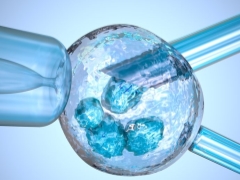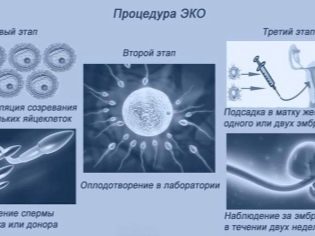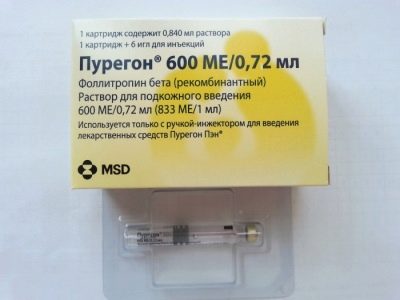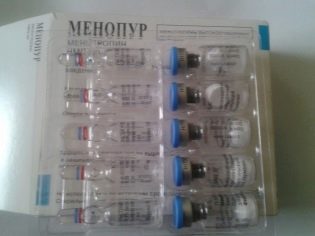Superovulation and stimulation of the ovaries before IVF
In vitro fertilization provides a real opportunity for infertile couples to become parents. The procedure is not as simple as it seems, and the woman often has to stimulate the ovaries to induce superovulation. What it is and how it goes, we will tell in this article.
What it is?
Stimulation of the ovaries before IVF is carried out only in a stimulated cycle. During normal operation of the ovaries without the use of any medications, one egg matures in a woman’s menstrual cycle, less often two.
Stimulation of the ovaries allows you to get several eggs at once in one cycle, which significantly increases the chances of selecting the highest quality oocytes, their fertilization and subsequent transfer into the uterus of the expectant mother. Ultimately, the likelihood of pregnancy increases.
After the couple has addressed the reproductologist, taking into account the true cause of infertility, an individual scheme is appointed - the “action plan” for the next month. This plan, drawn up for a specific woman, providing for a detailed description of the stages, their sequence, as well as hormonal preparations to stimulate ovulation and their dosage, is called a protocol.
Starting the next menstrual cycle, in which IVF is planned, a woman “enters the protocol”. This entry begins with the stimulation of the intensive work of the ovaries, so that by the middle of the cycle the doctor could get not one but several oocytes suitable for fertilization.
Stimulation of the ovaries completely changes the biological rhythm of life of the female body. The ovaries do not work as usual, but in an emergency mode. Stimulation before IVF is most often required with the first protocol. If a large number of eggs can be obtained, then in the following protocol (provided that the first does not bring a positive result), you can do without drug “shock” hormone stimulation, the doctor can use cryopreserved (frozen) eggs or embryos.
You can, of course, try to get pregnant in a natural cycle, without stimulation. In this case, the woman is transferred an embryo obtained from a single egg, without drug support, but the predicted effectiveness of such IVF is several times lower than with the stimulated protocol.
The condition of the female body to which the doctor seeks, appointing the stimulation of the ovaries, is called superovulation. This term hides multiple ovulation, in which 3-4-5 or even more follicles mature.
Sometimes there is a need for a long protocol in which drug support is prescribed, which at the initial stage causes an artificial menopause - menstruation stops, ovulation does not occur. After a few months, the doctor cancels such hormones and begins to stimulate the ovaries, prepare them for superovulation.
If a woman's causes of infertility are not rooted in hormonal disorders or menstrual cycle disorders, but in obstruction of the fallopian tubes, minimal stimulation can be assigned.Intensity, dosages are determined and adjusted as the woman is monitored: the doctor regularly monitors the effectiveness of treatment and the maturation of the follicles by ultrasound of the ovaries. The reaction of the gonads to the drugs taken is called the ovarian response.
How is the stimulation?
The process of stimulation usually begins on the 3rd or 5th day of the menstrual cycle. The countdown is from the first day of the next menstruation. The therapy lasts until about the middle of the cycle, when, according to ultrasound, the size of the follicles reaches a sufficient size. Then the procedure is prescribed puncture of the ovary. It is carried out in a hospital under general or local anesthesia. Through the back wall of the vagina, a thin and long cannula is inserted into the woman's ovary, which “pumps out” the contents of the dominant follicles along with the eggs.
Ovules undergo microscopic examination, the best of them are recognized as suitable for fertilization. Oocytes are placed in a nutrient medium, the sperm of the husband or the donor is also added there.
Fertilized eggs remain “matured” in the laboratory for another few days, after which they are again subjected to strict selection. Only the most viable and strong embryos will be placed in the uterine cavity of the expectant mother.
The more eggs received, the more of them successfully passed the fertilization stage and were considered suitable for transfer, the higher the probability of a successful IVF outcome. If “extra” embryos remain after replanting, as agreed with the attending physician, they can be frozen and will be stored in a demand cryobank. A woman will be able to use them in the next protocol or in a few years when she wants to give birth to another baby.
From the moment hormones are prescribed, which in the first phase of the cycle should ideally lead to superovulation, the control over the growth of the uterus and endometrium begins. Normally, the endometrium should "grow up" by 1 mm, and follicles by 2 mm every day.
If growth exceeds these standard values, the scheme is revised, adjusted for the likelihood of the development of a dangerous complication - ovarian hyperstimulation syndrome. If the growth rates of the endometrium and follicles do not reach the norm, the doctor may increase the dosage of hormones or change one drug to another. Ovarian response may be different.
Shock doses of hormones that are completely unusual for the female body outside IVF can have quite tangible negative consequences for the whole body, and therefore stimulation with minimal hormonal support is sometimes recommended in order to minimize the harmful effects. However, in such protocols, only follicles grow in the majority, the endometrium grows slightly, and its thickness is very important for fertilized eggs to implant and settle down.
In protocols with minimal stimulation, doctors often set a goal only to assemble a biomaterial - eggs and freeze them until the next protocol, when the endometrium is ready to accept a fertilized egg.
Stimulation in the short protocol lasts about ten days. The entire protocol takes one menstrual cycle. In a long protocol, stimulation can last more than 30 days.
When choosing a protocol type, the doctor focuses on the cause of infertility and related problems. So, with endometriosis, it will take a long time to “build up” the endometrium, so a long protocol is chosen. In particularly difficult cases, the duration of stimulation can be up to six months.
Sensations during stimulation
The effects of hormonal stimulation a woman usually begins to feel in the process of stimulation.The hormonal background is changing, the natural hormones are replaced by an excessive concentration of those introduced from the outside, and the state of health worsens markedly. A woman can literally have severe headaches, nausea, dizziness, nagging pain in the lower back and lower abdomen.
Due to a change in the hormonal balance of a woman's psycho-emotional state is disturbed, she becomes nervous, intolerant, tearful, irritable, she is overcome by bouts of severe anxiety, sleep is disturbed, abdominal distention and appetite disturbances can occur.
If, during the period of stimulation, transparent, rather abundant secretions from the genital organs appear, this is a good sign, indicating that the endometrium is growing at a rather rapid rate, and the chances of embryo implantation in the functional layer of the uterus after embryo transfer increases.
Preparations
Only synthetic hormones are used to stimulate superovulation. The doctor chooses the dosage based on the patient's own hormones, the state of the reproductive system, the cause of infertility, the age of the woman, and a host of other factors, including the ovarian response to stimulation.
In the first phase, follicle-stimulating hormone (FSH) drugs are taken, when the follicles are enlarged and ovulation is approaching, LH-based drugs are injected into the woman, which helps the egg to ripen quickly. Approximately 36 hours later, a puncture is prescribed - and the eggs, ready for a meeting with the sperm cell, are extracted from the ovaries.
If a woman plans to carry out insemination (do not confuse with IVF), then when follicles mature, preparations based on human chorionic gonadotropin (hCG) are injected, which provokes rupture of the shells of the follicles and the release of a mature egg. After that, the woman is injected into the uterine cavity of the sperm of her husband or donor. Conception, unlike IVF, does not take place in a test tube, but in the body of the future mother.
At the final stage after embryo transfer, women are prescribed preparations containing synthetic progesterone. It is this hormone that prevents the onset of regular menstruation, and also creates the most comfortable conditions for the developing embryo - it thickens and makes the endometrium of the uterus more friable, improves metabolic processes, partially suppresses maternal immunity so that the embryo does not reject, and also maintains smooth muscle of the uterus in a calm state , avoiding hypertonus and possible miscarriage.
The most popular and common drugs used during ovarian stimulation include the following.
"Orgalutran". This tool allows you to suppress the production of follicle-stimulating and luteinizing hormones, which is very important for controlled superovulation in the IVF protocol. The drug exists in the form of syringes with a solution for injection. At the recommended dose, it is injected subcutaneously in the hip area. It is important to remember to take the drug with certain time intervals, otherwise the pituitary gland will quickly restore its ability to synthesize FSH and LH. Usually the drug is taken for five days.
- "Pugeron". This is a drug with follicle-stimulating effect. It promotes the maturation of not one, but several follicles in the first phase of the menstrual cycle. Therapy “Puregon” is prescribed not only in the IVF protocol, but also before intrauterine insemination, as well as in the IVF + ICSI protocols. The drug is administered from 2-3 days of the menstrual cycle, the duration of 7 to 12 days, until the results of the ultrasound will not be detected preovulatory stage. Effective stimulation "Puregon" is considered for four protocols. Then the effect decreases and you need to change the drug.
- "Gonal-F". This drug exists in the form of lyophysilate for the preparation of injections after dissolution, and in the form of a ready solution for subcutaneous injections in the so-called "pen syringe".The dose of the drug per day should not exceed 450 IU. Every day from 2-3 days of the cycle, the drug is injected in different places subcutaneously. Prick means in the same place is strongly discouraged. Usually 12-13 days after the start of the application, the follicles reach an adequate size and can be removed by puncture.
- Menopur. Feedback on the stimulation of this drug is mostly positive. The tool is obtained from the urine of women who are in a state of natural age menopause. The drug affects the activity of the pituitary gland in the suppression of all follicles except the dominant, and therefore it is possible to get several oocytes that have matured and are suitable for fertilization. The drug also increases the thickness of the endometrium.
- "Meriofert". This drug also has a pronounced follicle-stimulating effect, promotes the growth of the endometrium, and also increases the level of estrogen. The drug can be administered subcutaneously and intramuscularly.
- "Klostilbegit". This drug is commonly used in “soft regimens” of IVF. With its help, the ovaries more quickly cope with the growth of several follicles, which will not fertilize in this cycle, but a little later. The dosage of the drug is purely individual. The response of the ovaries to the remedy is not always adequate.
How to make shots yourself?
Usually, doctors do not object to the woman doing the necessary daily injections on her own, before that she will receive detailed instructions on where and how to administer the drug. General requirements for self-fulfillment of doctor's prescriptions are as follows:
- subcutaneous injections are best done with special pens-injectors;
- any hormonal drug should be administered very slowly and slowly;
- shots should be given at the same time daily;
- if one injection is missed for some reason, you should call your doctor and get further recommendations;
- increase or decrease the recommended dose is strictly prohibited.
If a woman has a cold, flu or ARVI in the process of stimulation, if she was prescribed antibiotics, you should always contact your doctor to decide whether it is advisable to continue the stimulation or transfer the egg collection procedure to another menstrual cycle.
Possible complications
One of the most dangerous complications of stimulation as an IVF stage is ovarian hyperstimulation syndrome. In this syndrome, the ovaries increase in size due to the growth of a large number of follicles.
Symptoms of overstimulation are most often manifested by ascites (fluid accumulation in the abdominal cavity), in which a woman has a feeling of her own “bloating”. Abdominal pain can have different intensity, it is directly dependent on how much the woman’s ovaries have increased relative to normal size.
Breathing becomes more difficult, difficult, nausea, vomiting and diarrhea can occur. The fingers, legs, lower abdomen swell strongly, the arterial pressure decreases, and the woman’s well-being deteriorates markedly. The amount of urine excreted by the kidneys is markedly reduced. In a state of overstimulation, replanting of embryos is highly undesirable, since the probability of carrying a pregnancy, even if it occurs, will be minimal.
The most at risk of overstimulation of the gonads are blond women under the age of 35, women suffering from polycystic disease, and women who are prone to allergies and receive hormonal support for hCG in the second phase of the cycle.
The danger of overstimulation lies in the possibility of death, the development of heart and kidney failure, and the likelihood of rapid depletion of the sex glands.
Ovarian hyperstimulation can be avoided by the high qualifications of the doctor who leads the protocol, his willingness to respond quickly to changes in the woman’s well-being and the ovarian response.If the follicles grow too slowly, the dose of the hormonal drug should not increase dramatically; after determining the cause of the unsatisfactory growth of the follicles, it is sometimes necessary to completely change the drug. During the puncture, in order to avoid the development of hyperstimulation in the second phase, it is important to aspirate all the available large follicles.
In most cases, this unpleasant complication can be avoided, so do not panic. Trusting relationships with the doctor will help ensure that the process of stimulating the growth of follicles will proceed without dangerous complications and the remaining stages of IVF will be similar, ending in complete success.
Other possible complications of ovarian stimulation before IVF are the probability of multiple pregnancies, as well as the likelihood of ectopic pregnancy after embryo grafting, but it happens extremely rarely. During stimulation, especially if it is carried out over several protocols, a woman can get better. Also, some sources indicate the likelihood of early menopause after pregnancy, which was made possible by IVF precisely because of previous hormonal stimulation of the ovaries.
How to behave during the stimulation period?
Of course, it’s quite difficult for a woman to remain calm and measured, because hormones postpone an imprint on almost everything — her well-being is changing (not for the better), her libido is decreasing, the woman is experiencing not only emotional instability, but is also in a state of severe stress due to fears that attempt may fail. Nevertheless, doctors strongly recommend trying to pull themselves together and cope with their negative emotions, because stress is clearly not conducive to the successful implantation of embryos and the onset of a long-awaited pregnancy.
It is important for a woman to walk in the fresh air, eat fully. Attempts to stick to a diet or vegetarian diet should be a thing of the past. Diet and successful IVF are not compatible. In the diet of a woman should be a lot of vitamins, minerals. The menu must include animal proteins - meat, fish, dairy products.
The amount of fat in the menu should be somewhat limited. Proteins are extremely important, since their use in sufficient quantities somewhat reduces the likelihood of such an unpleasant complication as overstimulation syndrome.
For a woman who has entered the protocol and started stimulation, it is important to change her lifestyle. She should sleep well at night, take care of her health. Immunity, which may so inappropriately be undermined and weakened by a viral infection, influenza, high fever, is now necessary so that the female body can cope with a more important task. Therefore, it is important to stay away from the sick; during the seasons of epidemics, it is better to take a few days off or part of the holidays and save yourself from having to meet with sneezing and coughing people on the bus, subway, at work.
Smoking and drinking alcohol while stimulating the ovaries, as well as drinking coffee, cocoa, and strong tea can have a negative effect on hormones. From all this it is better to give up.
A woman can not go to the bath or sauna, go to the solarium, for a long time exposed to direct sunlight. Do not take any medication without the knowledge and approval of the fertility specialist.
If you have a headache, you should not immediately take hold of pain pills, and if you vomit, take antiemetics. Some discomfort and symptoms are better to endure - they are temporary.
If in the process of stimulation there are unusual discharge, for example, blood or "smears", you should definitely contact your doctor without delay. If the joints hurt, and many women, according to reviews, say that this also happens, you should also consult a doctor.
Reviews
According to reviews, during the stimulation period, many people experience increased sexual desire, but intimate relationships during this period are not recommended. Also, women are worried about bruises at the injection sites. Treat them as an inevitable, but not at all terrible "satellite" of IVF.
Women note that with the onset of stimulation, the breast increases, it becomes more sensitive. And among emotions, the desire to cry for no apparent reason prevails most often.
See the following video about IVF and stimulation.













































